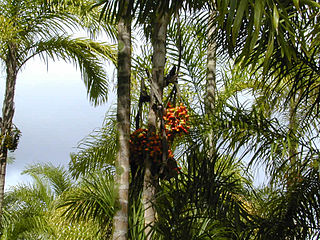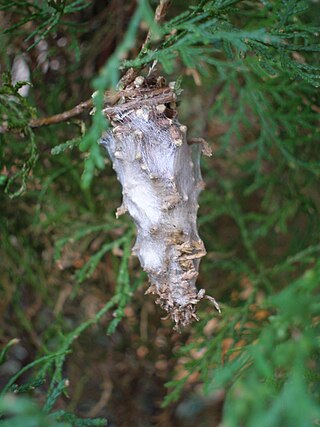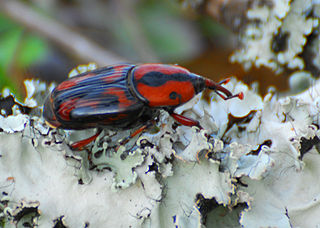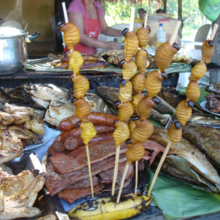
Bactris gasipaes is a species of palm native to the tropical forests of Central and South America. It is well spread in these regions, where it is often cultivated by smallholders in agroforestry systems or more rarely, in monoculture. Common names include peach palm in English, among others used in South American countries. It is a long-lived perennial plant that is productive for 50 to 75 years on average. Its population has an important genetic diversity, leading to numerous fruits, colors, and qualities. The fruits are edible and nutritious but need to be cooked for 30 minutes to five hours. They also benefit many animals in the wild. Peach-palms are also cultivated for the heart of palm, and the trunk can make valuable timber.

Bactris is a genus of spiny palms which are native to Mexico, South and Central America and the Caribbean. Most species are small trees about 2 m tall, but some are large trees while others are shrubs with subterranean stems. They have simple or pinnately compound leaves and yellow, orange, red or purple-black fruit. The genus is most closely related to several other spiny palms—Acrocomia, Aiphanes, Astrocaryum and Desmoncus. The fruit of several species is edible, most notably B. gasipaes, while others are used medicinally or for construction.

Hylobius abietis or the large pine weevil is a beetle belonging to family Curculionidae. This species is widely regarded as the most important pest of most commercially important coniferous trees in European plantations. Seedlings planted or arising from natural regeneration after clear felling operations are especially at risk. The adult weevils cause damage by eating the bark of seedlings around the 'collar' of the stem, thus 'ring-barking' the tree seedling which usually results in its demise.

The palm weevil Rhynchophorus ferrugineus is one of two species of snout beetle known as the red palm weevil, Asian palm weevil or sago palm weevil. The adult beetles are relatively large, ranging between 2 and 4 centimetres long, and are usually a rusty red colour—but many colour variants exist and have often been classified as different species. Weevil larvae can excavate holes in the trunks of palm trees up to 1 metre (3.3 ft) long, thereby weakening and eventually killing the host plant. As a result, the weevil is considered a major pest in palm plantations, including the coconut palm, date palm and oil palm.

Bursaphelenchus xylophilus, commonly known as pine wood nematode or pine wilt nematode (PWN), is a species of nematode that infects trees in the Pinus genus of coniferous trees and causes the disease pine wilt. While native to North America, it spread in the early 20th century to Japan and in the latter half of the century to other areas of Asia, including China, Taiwan, and Korea, as well as to Europe, including Portugal and Spain.

Otiorhynchus ovatus, the strawberry root weevil, is one of the many species in the weevil family (Curculionidae), occurring across Canada and the northern United States. The species was first described by Carl Linnaeus in his landmark 1758 10th edition of Systema Naturae. Its name comes from its affinity for strawberry plants, which form a large part of its diet. They are, however, known to feed on other plants as well. Occasionally the larvae cause serious damage to seedlings and young transplants in plantations and nurseries. It is known to be one of the major pests threatening sub-tropical strawberry farming.

Bursaphelenchus is a genus of nematodes (roundworms) in the order Aphelenchida. Most are obligate mycophages, but some feed on wood, with two species, the red ring nematode and the pine wood nematode, economically significant as pests of coconut palms and of pine trees, respectively. Given that Bursaphelenchus species are usually hard to distinguish from one another except by trained nematologists with access to microscopes or DNA sequence analysis, the entire genus is put under quarantine in some countries. Where this is not the case however, these nematodes are becoming established as model organisms for nematode developmental biology, ecology and genetics.
The red ring disease of coconuts and African oil palms is caused by the nematode Bursaphelenchus cocophilus. It is also identified in literature with an alternative scientific name Rhadinaphelenchus cocophilus. The common name, the red ring nematode, is derived from its distinguishing symptom.

Oiketicus kirbyi is a moth of the family Psychidae. It is found in lowlands from Argentina to Mexico and on the Caribbean islands.

The palmetto weevil is an insect native to Florida, but has been found as far as southern Texas to the west and South Carolina to the north. It is the largest weevil in North America and the only kind of palm weevil in the continental United States. It infests palms and is considered a pest. Its main target is the Canary Island date palm, but date palms, sabal palms, saw palmetto, Washingtonia, Pritchardia, royal palms, Latania, coconut palms, Caryota, and Bismarckia are also susceptible. Distressed palm trees are usually attacked, which makes transplanted trees a frequent target. The Palmetto Weevils mate at the base of the palm branches where the females deposit their eggs. The grubs then eat into the palm tree, killing it. After the larvae have turned into adult weevils, the damage can be seen, but by then, it is considered to be too late for the tree. The life cycle from egg to adult for a palmetto weevil is about 84 days. For prevention, it is recommended an appropriate insecticidal crown drench is done twice a year for high value palms.

The palm weevil Rhynchophorus vulneratus is one of two species of snout beetle known as the red palm weevil, Asian palm weevil, or Sago palm weevil. The adult beetles are relatively large, ranging between 2 and 4 centimetres long, and vary from a rusty red colour to almost entirely black; many colour variants exist and have led to considerable confusion with other species. Weevil larvae of these species can excavate holes in the trunk of a palm tree up to 1 metre long, thereby weakening and eventually killing the host plant. As a result, these weevils are considered major pests in palm plantations, including the coconut palm, date palm and oil palm.

Rhynchophorus bilineatus, common name Black Palm Weevil, is a species of beetles belonging to the family Curculionidae.

Rhynchophorus, or common name palm weevils, is a genus of beetles in the weevil family, Curculionidae. Palm weevils are major pests of various trees in the family Arecaceae throughout the tropics including: coconut, Areca catechu, species of the genus Phoenix, and Metroxylon sagu. Two species are invasive pests outside their native ranges, Rhynchophorus ferrugineus and Rhynchophorus palmarum.

Elaeis guineensis is a species of palm commonly just called oil palm but also sometimes African oil palm or macaw-fat. It is the principal source of palm oil. It is native to west and southwest Africa, specifically the area between Angola and The Gambia; the species name, guineensis, refers to the name for the area called Guinea, and not the modern country Guinea now bearing that name. The species is also now naturalised in Madagascar, Sri Lanka, Malaysia, Indonesia, Central America, Cambodia, the West Indies, and several islands in the Indian and Pacific Oceans. The closely related American oil palm E. oleifera and a more distantly related palm, Attalea maripa, are also used to produce palm oil.

Caenorhabditis angaria is a small nematode, in the same genus as the model organism Caenorhabditis elegans. The name is from the Latin after the tendency to ride weevils. Prior to 2011, the species was referred to as C. sp. 2, C. sp. 3, and C. sp. PS1010. Its genome was sequenced at the California Institute of Technology in 2010. This species is gonochoristic. It has distinct morphology and behavior compared to C. elegans; notably, C. angaria males exhibit a spiral mating behavior. Its divergence from C. elegans is similar to the distance between humans and fish. C. castelli is its closest relative, and the two species can produce F1 hybrids.

Hypera nigrirostris, commonly known as the lesser clover leaf weevil, is a species of weevil that is native to Europe and northern Africa and has been introduced to North America and Japan. Both adults and larvae feed on red clover and other plants in the family Fabaceae.
Trichobaris trinotata, commonly known as the "Potato stalk borer", is a species of weevil in the family Curculionidae. It is found in North America where it is a pest of potato plants, the larvae tunnelling inside their stems.
Listronotus oregonensis, the carrot weevil, is a species of weevil in the beetle family Curculionidae. It is found in North America.
Diocalandra frumenti, commonly known as the palm weevil borer, the lesser coconut weevil, or four-spotted coconut weevil, is a species of weevil in the family Curculionidae. It occurs in Africa, Southern Asia and Northern Australia, and is a pest of coconut and other palm trees.

Mojojoy is the name of larvae of different palm weevils found in the Amazon region of Colombia, eaten as food and are known as a pest for various palm species. In Peru, it is known as suri or cocotero. The flavor has had different descriptions including resembling the taste hazelnut or butter. It is also considered a sustainable food source.

















